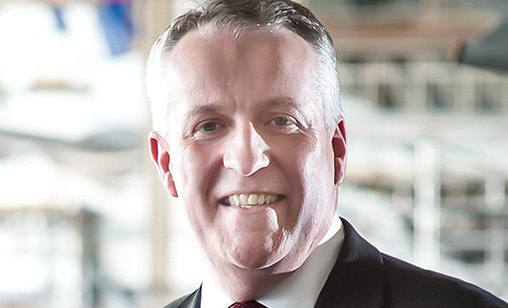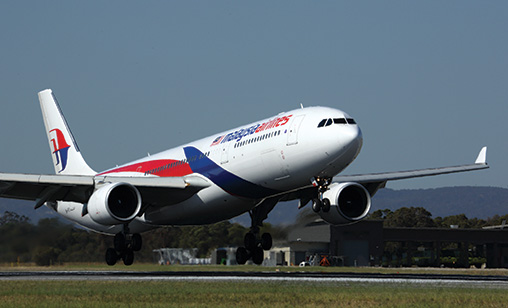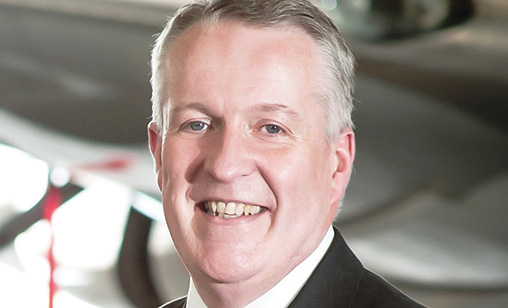Cover Story
Marketing the new Malaysia Airlines
Malaysia Airlines Berhad is emerging from the most traumatic period in its seven decade history. After the loss of MH370 and the shooting down of MH17 in 2014 passengers abandoned the carrier in their millions, forcing the Malaysian government to rescue the near extinct airline. Last month, MAB’s group managing director and CEO, Peter Bellew, told Orient Aviation chief correspondent, Tom Ballantyne, that passengers are returning to the airline, including Mainland customers who deserted the carrier two years ago.
October 1st 2016
Ask Malaysia Airlines (MAB) Irish-born group managing director and chief executive, Peter Bellew, where the carrier sits in its turnaround program and he turns to a football analogy to reply. Read More » “I’d say we are about twenty minutes into the first half of the match and we’ve just started breaking out of our own half,” he said.
“A lot of the work we have done in the last twelve months was about reducing costs, dealing with contracts, restructuring finances and generating cash on the balance sheet. Now, we are moving into the maximizing revenue stage.”
 |
| Peter Bellew MAB’s group managing director and CEO |
The first good news on that front arrived with the results for last February. The airline made its first monthly profit in several years. But the figures weakened in the second quarter because the religious month of Ramadam, when adult Muslims must fast for 17 hours a day and are encouraged not to travel, began on June 7. At least 60% of Malaysians are Muslim.
Load factors have been disappointing at below 70%, Bellew said, but “forward booking patterns strengthened in the third quarter. We expect an improved performance in business class loads in the fourth quarter”, he said.
“We’ve gone on a massive marketing drive and it’s paying off. In the last eight weeks, our load factors have picked up fairly dramatically,” he said. “Somewhere like London, where we have fairly vicious competition from British Airways, Etihad, Emirates and Qatar Airways - who are offering extraordinarily low fares - we have pulled back eight per cent in market share.
“We are winning business in a whole load of places. That’s purely from being very public and doing more advertising than we’ve probably done for five years.”
Before he took charge at MAB on July 1, following the unexpected resignation of his predecessor, Christoph Mueller, Bellew was COO at the carrier and was instrumental in planning its rehabilitation. In fact, Mueller and Bellew have made history at the airline as the only two non-Malaysians to have headed the flag carrier.
As CEO, Bellew has not skipped a beat. A largely successful $1.5 billion restructuring program has encouraged him to believe the 2018 target for profitability at the airline can be achieved.
“There is no line of revenue we are not trying to maximize and no line of cost we are not trying to reduce. Literally, every hour of every day we are chasing revenue. In the past, the company traditionally had a very medium to long-term view on planning and marketing,” he said.
“It’s not enough anymore to publish your summer schedule nine months in advance, throw out a bit of advertising and hope business will come to you. We have to be much more flexible in our approach, be proactive and reactive simultaneously, which we have not been doing for the longest time.
“We’ve been very aggressive on our sales and marketing in the last eight or nine weeks and we’ll continue to do that for as long as we are in business. Our revenues and our average fares are holding up pretty well at the moment.”
There’s another significant development that will underpin the airline’s balance sheet if, as planned, it hits that return to profit date: a fleet modernization that will benefit the bottom line.
At one stage, MAB had 17 B777s, as well as 20 B747-400s. They have now gone from the fleet.
 |
Next to go will be MAB’s six A380s. They will be replaced by six A350s, with the first of the new aircraft type scheduled for delivery in Kuala Lumpur in the first quarter of 2018. “The A350, in particular on the London route, will make a significant difference to us. We are an operator with one of the longest flights every day in the world - 14 hours - to London twice a day. It is an expensive run for fuel and quite a competitively priced route,” he said.
At the Farnborough Air Show last July, MAB added to its re-fleeting plan with an order for 25 B737MAX 8s, with options for another 25. The list price was US$5.5 billion, but that is not what MAB is paying for the planes.
“The B737 MAX aircraft we bought cost about 40% less than the current B737-800s and they use 15% less fuel. This is going to be an absolute game changer for Malaysia Airlines. The economics of the airline will be transformed from late 2018 to 2020. It will be night and day in cost structure,” he said.
Not long before he spoke to Orient Aviation last month, Bellew had looked at the airline’s projected budgets for the third and fourth quarters of 2018. “We saw immediately the massive changes in fuel efficiency once we shift from the A380 to the A350 in those quarters,” he said.
“At the same time, every other cost item [at the carrier] we will attack day by day, week by week and month by month between now and then to achieve modern cost levels.”
There has long been speculation about the fate of MAB’s A380s as the airline reduced its long-haul network and focused on Asia. Bellew repeated his intentions, made clear in recent interviews, that the carrier would operate some of the A380s through to the Hajj in 2018 and then exit them from the fleet in the second and third quarters of 2018.
“We’re talking to people about sales, wet lease, dry lease and combinations of that. Two years from now is not very far away in the aviation life cycle. We will have to find a way of cost effectively managing those aircraft over their life cycle.
“We are trying to sell them. We have interest in some of the aircraft, but the market is challenging for a plane that size in the short-term.” However, Bellew said there are airlines interested in “dipping their toe in the water with the A380”.
MAB has the ability to provide support for the aircraft, with fixed base simulators in Kuala Lumpur, engineering capacity, painting, electronic and component shops as well as instructors, pilots and cabin crew, he said.
“We will be in a position to work with the government and a third party customer, whether it’s wet leases, dry leases or any combination of assistance needed to ensure the aircraft keep flying. It’s the solution you need to offer in today’s world,” he said.
 |
| 'Our business from China is really, really strong at the moment. If I had another four or five A330s today I could start routes into China very quickly and they would be successful, no doubt' |
| Peter Bellew MAB’s group managing director and CEO |
“I don’t think you can just stick an advert in Orient Aviation or Flight International and expect people to come banging your door down.”
One of the critical factors in MAB’s restructuring has been the renegotiation of contracts with suppliers. “We have not touched the service elements at all,” said Bellew.
“In fact, we’ve improved them. Malaysia Airlines had been cutting costs, but sometimes paying a higher price for a reduced service. So in every element of the procurement process we are including very strict service level agreements. They are quite common in Europe, but less common here.
“We have increased the amount of food and the quality of food we are giving people, but we are paying a lower price for it. We have generally reduced the cost of ground handling by significant amounts and we have put in new service level agreements on punctuality, turnaround times, ground service equipment quality and the like,” he said.
“Now, a lot of procurement is about ensuring we receive the quality produce we are paying for. Previously, we were paying far too much. There were no penalty clauses for suppliers who basically gave us poor service levels.”
In the last six months, MAB has done “a massive deep clean” on the fleet, said Bellew, including new business class seats on its wide-bodies, rejuvenating lounges, upgrading facilities at its various locations and sprucing up the carrier’s visual image. “The product is much better than it was a year ago and we are paying a lot less at every touch point for that quality,” he said.
The next step in Bellew’s strategy is making a big push for a greater presence with the region’s travel agents. “It is incredibly important in Asia. It’s probably the last market in the world where travel agents completely dominate the business travel market. For us, in the next five years, it will probably differentiate us from a lot of the competition because we have a significant business class product.
“We’ve gone to great lengths, and we will continue to do so in the next couple of years, to improve MAB’s business class,” he said.
One bright spot in MAB’s battle to achieve profitability is a recovery in its Chinese business, a market badly hit by the still unresolved loss of MH370 in March 2014, with 239 people on board, and the shooting down of MH17 in the following July, killing all of its 298 passengers and crew.
“Our business from China is really, really strong at the moment. If I had another four or five A330s today I could start routes into China very quickly and they would be successful. No doubt,” said Bellew.
“We are talking to a number of airports in Mainland China. We hope to put in place some new routes on the Mainland and announce them by the end of this month.”
A deep code share partnership with Emirates Airline also is a winner. “Emirates is a very good partner. We are on a code share on a lot of routes to Europe and it’s working very well for us. It is very different to the partnership Emirates has with Qantas,” he said.
“Qantas literally flies a lot of metal to Dubai, finishes the flights and transfers its passengers on to Emirates to all over the world. We don’t fly to Dubai. We actually quit flying to Dubai as part of the code share process. So we sell a lot of people on Emirates metal and they likewise are selling people on to our metal.
“It’s more akin to a traditional code share rather that a major metal partnership, for want of a better phase,” Bellew said. “The arrangement is giving MAB customers a range of choices they had not had, with great connectivity through Dubai twice or three times a day to many European destinations. Emirates has four flights to Kuala Lumpur daily, including two with A380s. They are operating capacity of 605 seats. They have a lot of seats here at great prices.”
MAB faces fierce competition across its network, particularly with regional rivals and Southeast Asian budget carriers. “It’s good fun,” said Bellew. “There’s never a dull day in KL. You can fly with Malaysia Airlines to places around the region for 99 ringgit, which is basically US$25, and that’s a fully inclusive price.
“There are a lot of sneaky charges imposed on passengers by many airlines in the region. You might pay $1 for your ticket, but you can be charged another $50 by the time you add the extras and taxes. Yes, it’s tough. But we are in a unique position. We have a substantial and very profitable business class that we have not aggressively marketed for a number of years.
“We have that on all our fleet. Down the back, we have been operating at less than 70% load factor and we have seats we can take a view on. We have been using more modern revenue management techniques in the last couple of months so we have a number of seats we can book early at the lower fare and then progressively go higher.
“There is tough competition here, probably some of the toughest in the world. There’s a lot of capacity, but we have a strong brand in the region. We have a nice airport with plenty of capacity. We have a relatively modern fleet. We have great, experienced well-trained staff so we play to all our strengths.
“If you take a three to five year view of things, we think we will be on the soccer pitch long enough and we’ll score some goals. Maybe some other people will score some own goals or will be sold. Or there will be consolidation in the region. But we’ll still be standing.”
MAB has returned to fuel hedging after a hiatus forced on the carrier by its poor financial performance. “We are about 60% hedged to the end of this year. We are planning to, and are close enough to getting that in place for the first quarter of next year as well. We have a fairly conservative hedging policy, rolling a year ahead and trying to always be around 60%,” he said.
Currency fluctuations are another challenge. MAB cannot readily mount a defence against a decline in the country’s currency because of its weak balance sheet. “We were not in a position to have a counter party for any hedging we wanted to do. We don’t have any natural hedge against the [US] dollar because we have no revenue in dollars, nothing remotely significant.
“But our budget has actually been pretty close to what the exchange rate has ended up being although when we were doing it the Ringgit was in a different place. We called that pretty well. There is stability about the Ringgit now, at a relatively bad rate. That is what we are budgeting for in the next couple of years.”
One management issue that has settled down is staff morale, which clearly took a beating after the two aircraft losses and the deep staff cuts demanded by the turnaround plan. “It’s been a really interesting experience for me because I come from rural Ireland where family is everything,” he said.
“In fact, often in Ireland all you interact with on long winter nights is your family and your extended family,” he said. “When I came to work here, I thought I was here to turn around an airline. I realized fairly quickly that Malaysia Airlines is one giant family.
“A lot of the people that work here are genuinely related to each other. If they are not, they know each other and they’ve had parents and grandparents, uncles and aunts (working) here. So there is a certain camaraderie here.
“Through all the difficult times the company has experienced, in many different ways there is a great tenacity about the family sticking together. It is what I have experienced here. I think morale is really, really good at the moment. Everybody is giving it their best shot. Everybody is supporting each other and they are doing it for the family.
“This is something we can develop and it is going to make the place different. As we are now coming out of the bad times, it’s much more that success will keep us together. It will keep us level headed so we don’t start doing stupid stuff.”
As for the challenges ahead, Bellew recognized there are plenty. “The aviation business is remarkable. Long-term planning sometimes is Friday and everything changes on Tuesday,” he said. “You use your crystal ball.
“I think fuel prices are going to go back up. Fuel costs, relative to our overall cost base, are not nearly as significant for us as they are for a low-cost airline. We face competition from the so-called low-cost long-haul airlines. I don’t see that model working, but we have to bear with that for a few years.
“As fuel prices rise - and I’m sure they’ll go through the roof within three or four years – there will be consolidation among the budget long-haul airlines back into mainline carriers.
“If you don’t have a business class product, it’s very hard to consistently operate routes twelve months of the year over a number of years and bear the costs of long-haul operation. That’s one challenge we face, but I see it changing over time.”
Another pressure Bellew believed would increase is insufficient air traffic control capacity. “Already, we are seeing certain days going into some Asian countries where you are almost locked out because the weather is bad and the ATC has problems. There’s just no capacity. You have to divert or turn back and that’s an issue,” he said.
“Look at the order books in Malaysia and Indonesia. There are twice as many aircraft on order with these countries - nearly 800 - as there are in all of China at the moment. If only half of those aircraft arrive in the system in the next five years, there will be no air traffic control capacity for those aircraft and there will be no runways for them to land or take off.”
But for Malaysia Airlines, Bellew said, the biggest challenge of all is complacency and lack of hard work. “That’s our biggest threat. So that’s up to me, to make sure I get out of bed early in the morning and to make sure everybody else does as well,” he said.